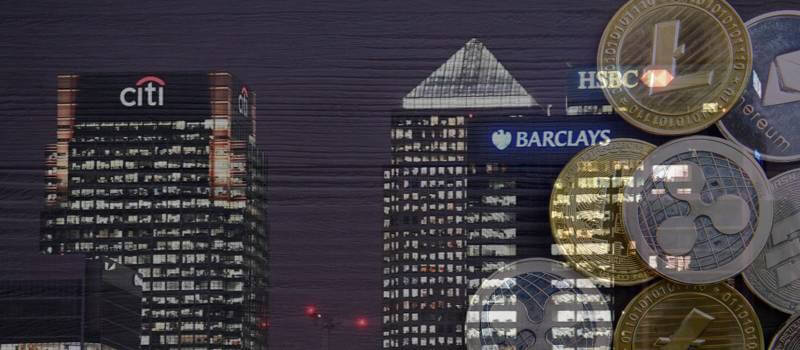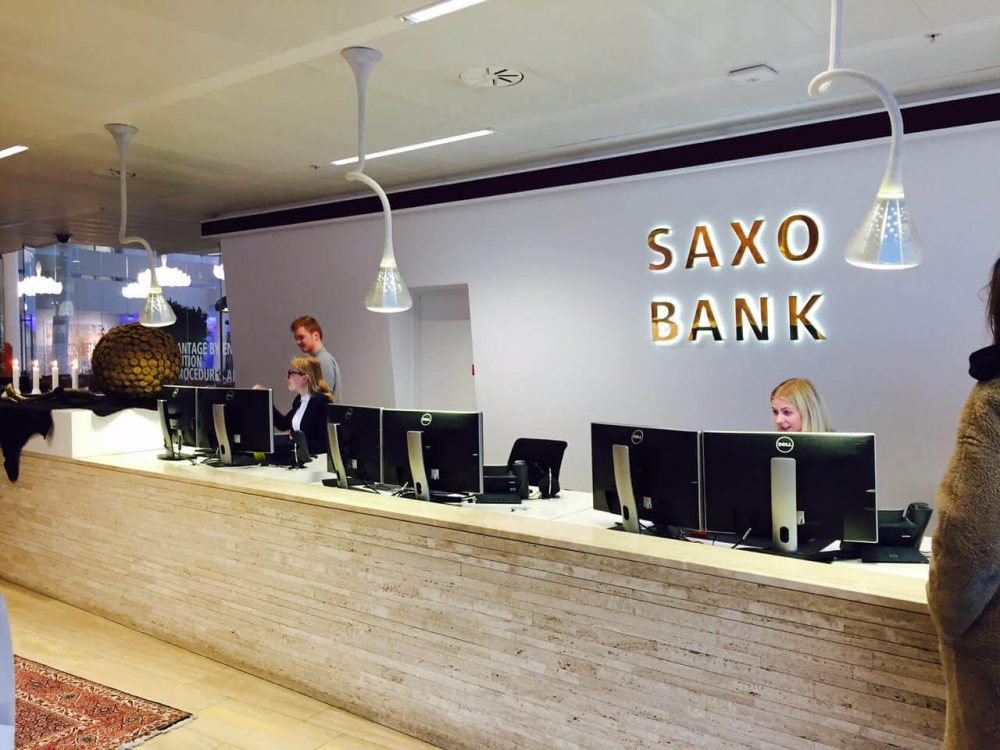
The world’s biggest banks are pouring billions of dollars into crypto
So far this year, billions of dollars in institutional and retail capital has poured into Crypto adoption, leading to a boom within traditional and institutional circles. The nascent market even touched $2 trillion earlier in the year. This is only the beginning, according to a recent report from the crypto research firm Blockdata, which shows that over fifty-five of the world’s biggest financial institutions have already invested in crypto and blockchain-related startups. “The most active investors, based on the number of investments in blockchain companies, are Barclays (19), Citigroup (9), Goldman Sachs (8), JPMorgan Chase (7) and BNP Paribas (6),” the Blockdata report noted, adding: “The investors active in the biggest funding rounds are Standard Chartered, BNY Mellon, Citigroup, UBS Group, and BNP Paribas.” As per a separate report from Business Insider, Standard Chartered is an investor in the payments processor and XRP issuer Ripple, with the latter’s investors including the likes of Bank of America and American Express. Another financial powerhouse, BNY Mellon, already offers crypto custodian services and has made strategic investments in Fireblocks, which is a digital assets infrastructure provider.
As per the report, Standard Chartered leads with over $380 million invested over six rounds. The bank is followed by BNY Mellon ($320.69 million over five rounds), Citigroup ($279.49 million over nine rounds), UBS Group ($266.2 million over 5 rounds), and BNP Paribas ($236.05 million over nine rounds). The data shows crypto custodian and storage services are gaining most of the investments from financial institutions, with twenty-three of the top one-hundred banks either building custody solutions or investing in the companies that provide them. These services are integral to the growth of the broader space since the storage and safety of one’s assets remains paramount when the value of these assets is in the billions of dollars. This stands firm, even though crypto is an entirely ownable, peer-to-peer asset class. As Blockdata explained in its report, “Not everyone feels comfortable holding full control over their own wealth, especially companies or institutional investors that hold large amounts.”
Total crypto market cap back above $2 trillion, FUD now a distant memory
The total crypto market cap edged above $2 trillion early last week, making a 12-week high as the market leader, Bitcoin, targeted $50,000, which is a level not seen since FUD ramped up just as the summer season got underway. Many were filled with worries that we were about to return to another “crypto winter.” However, strong performances over the past few weeks have put those worries to rest and we are now talking about the next wave of the bull market. Ever the joker, Elon Musk started sounding the alarm on the environmental damage caused by Bitcoin mining, leading him to withdraw BTC as a Tesla payment option (is anyone buying his cars anyway?). More recently, during the ฿ Word conference, he said he would revisit this decision and possibly reinstate BTC as a payment option, and that this was subject to confirmation that renewable sources accounted for 50% or more of the mining process. Considering his trolling of the Bitcoin community at the time, many say the damage to his reputation has already been done. Right after Musk’s rants, China began enforcing a crypto crackdown within their country (it truly seemed like a coordinated attack against crypto).
Even though Chinese authorities had committed similar actions against crypto in the past, this time the forced closure of mining operations across Sichuan, Henan, Gansu, and Anhui provinces showed that the CCP was deadly serious. At the time, Bitcoin dipped to as low as $29,800, which was a fifty-five percent drop from its all-time high of $64,000. The hash rate also plummeted. Just as Musk seems to be walking back his earlier statements, the China-FUD has now also died down. Bitcoin has posted a 60% gain from those early summer lows, and the hash rate is also recovering. The U.S and Kazakhstan seem to be benefiting from the Chinese mining exodus. Although the total crypto market cap is currently at $2 trillion, it’s still some $500 billion short of its pre-FUD peak. Having bottomed at $1.2 trillion in mid-July, the bulls are seeing a strong recovery, and this is bringing with it renewed optimism. Ran Neuner, CEO and co-founder of OnChain Capital, thinks the bulls will be quite happy. “I don’t know who needs to hear this, but we are about to see the biggest bull run of our lives.” Over the 7-day period prior to Monday of last week, we saw XRP up 58%, Solano up 57%, and Cardano sizzling with a 48% gain. Sustaining this run will depend upon what Bitcoin will do. However, with many investors calling for a BTC end-of-year price target of $100,000, it looks like Neuner just might be correct with his call.

XRP, Ethereum fall as popular index flashes ‘Greed’ sign
The crypto fear and greed index, which is nothing more than a collective metric that estimates the current sentiment on the crypto market, remains in the “greed” zone, and yet most of the major cryptocurrencies entered last week with a price uptick. This index is meant to reflect daily emotions and sentiments for Bitcoin (BTC) and other large cryptocurrencies. These attitudes are gathered and analyzed from different sources, such as, amongst others, current market volatility, volume, momentum, and social media behavior. Scaling from 0 (maximum “fear”) to 100 (ultimate “greed”), the measurement typically passes through the “neutral” range (50) and moves into the “greed” zone during periods of strong price rallies, which typically occur when demand for crypto outweighs supply. Following Bitcoin’s price drop in mid-May, the crypto fear and greed index was, not-surprisingly, indicating “fear” in the market and this lasted for more than two months. Market sentiment began to reverse in late July and finally, the Bitcoin metric began revisiting the “extreme greed” level on August 14.
Similarly, the Ethereum (ETH) fear and greed index has also been residing in the “greed” zone recently. Following the major Ethereum network upgrade that launched on August 5, sentiment surrounding the world’s second-largest crypto by market cap also escalated to a state of “extreme greed.” The long-anticipated London hard fork included the EIP-1559 upgrade, which is a reductive measure set to reign in the crypto’s supply growth. Of course, this drove the price of Ethereum up, nudging the fear and greed index pointer to “extreme greed” on August 8, when it jumped all the way up to 79 points. This index has two simple assumptions: “extreme fear” signals investors’ worry and is an opportunity to buy, while “extreme greed” customarily announces the market’s readiness for a correction. Since these tendencies of provoking extreme sentiment have just recently landed, seasoned investors know that there is still the possibility of a lot of room left for greed to do its magic and drive the prices even higher (for now).

Economist claims a $500,000 Bitcoin would be disastrous for CO2 emissions
Alex de Vries, the founder of Digiconomist, predicts that, eventually, the cost of mining a Bitcoin will rise to the price of a Bitcoin. He was referring to the economic theory which states competition will drive profits down over time, and his website studies the consequences of digital trends from an economic perspective. According to his posts there, under this scenario, competitive mining will generate further environmental damage by producing more carbon dioxide. He concludes that the domino effect of a $500,000 Bitcoin would compound the issue to a large degree and then lead to an environmental disaster. Since many in the crypto world claim that the BTC network already runs to a great degree on renewable sources, could it be that de Vries’s report is simply another FUD attempt to crash the Bitcoin party? Since bottoming at $29,800 in mid-July, Bitcoin has posted a strong recovery, and even more so for the past two weeks as the bulls make the charge in the hopes of taking $50,000. This, of course, is a key psychological price level. During these past two weeks of the bull, talk of a new crypto winter has all but disappeared, and we are now squarely looking right into the real prospect of a $100,000 end-of-year price.
Bitcoin’s rising star has once again reignited a wave of lofty price predictions, including a $300,000 end-of-year target from on-chain analyst Willy Woo. Indeed, we even now have Dan Held’s extreme $9.5 million per token price prediction at some point in the future. However, should the price of Bitcoin approach these sky-high levels, de Vries (and others) fear that the network’s carbon footprint would expand to disastrous proportions. The reasoning is that the environmental cost of a booming BTC price follows that the laws of supply and demand, and so if the price of BTC goes up, this will increase mining revenue and profitability. As BTC becomes increasingly scarce over time, this, in turn, will attract more miners to join the network, pushing up mining difficulty, and in the long run, making an already competitive endeavor even more competitive and less profitable. Using de Vries’s calculations, the dynamics involved with a $500,000 Bitcoin price would produce 617 million metric tons of CO2 a year – an amount far greater than most individual countries. According to his website, “That volume exceeds the footprint for Australia by 56%, Brazil by 40%, South Africa by 40%, and Mexico by 33%. Bitcoin mining would be spreading 70% more carbon gases annually than the United Kingdom’s 352 million metric tons.” However, questions over de Vries’s claims exist. For example, a 2019 study by CoinShares estimates that almost three-quarters of the Bitcoin network runs on renewable energy. If so, this would largely negate de Vries’s claims of a CO2 disaster. FUD, fake news, reality: who do you believe?

BEST INDICATORS TO TRADE BITCOIN? THIS CARL ‘MOON’ PODCAST HAS THE ANSWER
For those who don’t know who ‘Carl the Moon’ is just yet, take a look at last week’s episode of CryptoNites. He’s a popular crypto investor and educator who runs a YouTube channel about Bitcoin news, and he is known for his easy-to-watch videos for crypto newcomers, which explain technical analysis in simpler terms. Recently, he spoke with Alex Fazel, the host of the crypto edutainment channel Cryptonites on Part 2 of Fazel’s podcast. Of course, Carl discussed all things Bitcoin, including his take on the best indicators to trade cryptocurrencies, chart patterns, and Bitcoin trends in 2021. Regarding altcoins, Carl said, “I have a reasonable exposure to altcoins. I think that’s rational to have because we know that all schools tend to go up a lot. And I only care about all schools going up against Bitcoin, I don’t care about going up against the US dollar. So, I want to end up with more baseball in the end.” He then added, “I will suggest doing some basic research, of course, not just going and buying random dual-core market cap. But also, you don’t want to buy scams, right, and there are a lot of bad products out there. What I basically tried to do is I rely on information from people that I trust, and I know that they did a lot of research and I take a look at it, of course and then I buy but we’re trying to stay to what I understand”
When Fazel asked him about emotions in trading, Carl suggested, “If you’re buying something without believing in it, without knowing what it is, then the volatility will get to you, you will be emotional. And that is why I don’t have a lot of exposure to these altcoins, for example, because I don’t understand them well enough to hold if they were to dump 60%.” He added, “I think people should always do research, you can buy altcoins that’s completely fine. But in that case, you should do a lot of research, actually just as much research that I did on Bitcoin, which is like, weeks and even months maybe, like extensive research to understand the fundamentals.” He felt that nowadays most new investors do not do due diligence regarding their investments, and this would hurt them in the end. “[Research] what goes into the narrative of why to buy bitcoin. But people just don’t do this in articles at all. People simply buy based on hype or what their friend bought, or something pumped 100% this week, now they want to buy it. It’s a very risky way to get into crypto.”
He then concluded with which indicators he would put more emphasis on when making investment decisions. “People think that the more indicators the better, but in my opinion, you should just choose two-three indicators that you’re comfortable with, get comfortable with them, and learn them and then develop a strategy. Take a look at chart patterns because when you have converging support and resistance formulas to triangles, you have something to treat whenever price breaks out, you enter a trade and you can make money and you don’t really need any fancy indicators for this, to be honest.” It seemed like he had found his favorite along the way. “The RSI is very, very cool to take a look at oversold or overbought [levels]. And one of my favorite things to use the RSI for is the bullish and bearish divergences. So, when you have a divergence between the RSI, and the price to where they basically go against each other, that is usually a sign of a trend change. And that can be very, very powerful.”
You catch the rest of the exciting CryptoNites podcast with Carl’s thoughts on Bitcoin prices, DeFi, and other trending topics by clicking here.

Ethereum’s Vitalik Buterin isn’t sold on Dorsey’s Bitcoin plans
In a recent interview, Vitalik Buterin, a co-founder of Ethereum, has revealed his doubts about the plans Jack Dorsey and Mark Zuckerberg might be making about the crypto industry. As per a report on Bloomberg late last week, Buterin was skeptical about Dorsey and Zuckerberg. The Ethereum founder, during the interview with Bloomberg TV, noted that Jack Dorsey would have to create his own system to bring DeFi capacity to BTC. In his words, “on Ethereum there’s native functionality that allows you to essentially directly put ETH or Ethereum-based assets into these smart contracts, into these lockboxes, where there are then arbitrary conditions that can govern how those assets get released.” He added that, “Jack is basically going to have to essentially create his own system that enforces those rules.” Speaking on Zukerberg’s idea of turning Facebook, Inc. into a “metaverse company,” the crypto industrialist noted that Zukerberg has been involved with a widely scrutinized Facebook-backed cryptocurrency project. To this, Buterin added, “there’s just a wide margin of mistrust about Facebook.” He admitted that constructing its own platform could prove otherwise, but instead, he would advise Zuckerberg to “build on an existing blockchain.”
Putting this in perspective, one has to be familiar with Dorsey and Zuckerberg’s crypto dream. Dorsey, CEO of Square, recently revealed his plans for Bitcoin, saying that Square would be creating a new business unit which would be focused on building an open developer platform in order to make financial services more decentralized, permissionless, and non-custodial on Bitcoin. The Twitter founder also revealed that Square would work towards building a hardware wallet and service whose primary goal would be to drive Bitcoin custodial services more mainstream. All of Dorsey’s plans, coupled with his outspoken support for the star asset, has led some investors to refer to him as the “face of Bitcoin.” On the other hand, Facebook’s CEO Mark Zuckerberg recently revealed that he believed the future of the social media giant could be in the metaverse sphere. At the same time, the Facebook founder is also backing a crypto asset by the name of Diem, which has drawn some level of criticisms and concerns from regulators around the world.
The post Digital Asset Insights #29 appeared first on JP Fund Services.






































